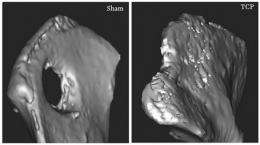Dutch researchers develop smart biomaterial that triggers bone growth

Researchers from University of Twente's MIRA research institute and its spin-off business Progentix Orthobiology BV have developed a biomaterial that promotes the formation of bone tissue. It can be used to repair bone tissue that can no longer regenerate itself. Research that was recently published in the leading scientific journal PNAS shows that the material can repair fractures that fail to heal just as effectively as the methods that have been in use until now, but without the drawbacks.
There are currently two treatment methods for patients who - due to an accident, old age or a tumour, for example - are missing part of a bone or suffering from a fracture that will not heal of its own accord. Doctors transplant a piece of bone from elsewhere in the patient's body, from the hip for example, to the affected area, or they use proteins that are produced naturally in the body (bone morphogenetic proteins (BMPs)) which instruct the body to produce new bone cells. However, there are disadvantages associated with both of these methods.
The drawback of the first method - transplanting a piece of bone - is that the quantity of bone available is extremely limited and that the patient has to undergo an operation in two places (once to remove the bone, and a second time to implant it at the affected site). The drawback of the second method - using BMPs - is that they are extremely expensive and it is also difficult to localize them at the right spot in the body. If the proteins spread around the body, they may cause bone growth in the wrong places.
Scientists from the University of Twente and the spin-off business Progentix Orthobiology BV have now developed a ceramic biomaterial made of porous calcium phosphate, which can be used to repair fractures that will not heal. The ceramic granules are placed at the location in the body where bone tissue is missing. The material then stimulates the body to produce new bone cells at the site of the defect. Over time, the biomaterial will be broken down completely by the body.
Research recently published in PNAS demonstrates that the biomaterial works just as well as the existing methods (transplanting a piece of bone), but without the disadvantages associated with those methods. The researchers demonstrated that the newly developed biomaterial causes the body to produce new bone cells, but it is not yet clear exactly why. It is clear, however, that stem cells play a role in the process. The researchers will now try to unravel the mechanisms at work in follow-up research.
The University of Twente and Progentix Orthobiology BV have now been working on developing and perfecting this biomaterial for ten years. The researchers expect the biomaterial to be ready for clinical use within a few years.
More information: 'Osteoinductive ceramics as a synthetic alternative to autologous bone grafting' by Huipin Yuan, et al. PNAS.
Provided by University of Twente
















